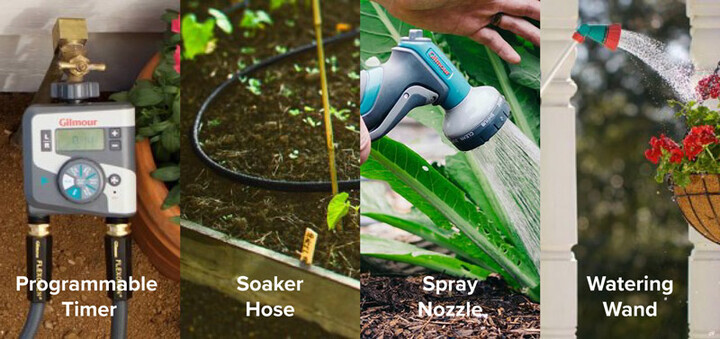We all grow up knowing plants need soil, sunlight and water, but we often don’t realize the importance of consistently watering flowers. A lack of moisture can cause a flower garden to wilt and produce very few – if any – blooms. Overwatering flowers can cause disease and the drowning of plants. Whether you have annuals, perennials or flowering shrubs, knowing the best way to water these plants is key to a showy abundance of blooms that will be the envy of the neighborhood.
Watering Flowers
1.Help New Plants Establish
Both young seedlings and young plant transplants are very susceptible to stress. To give them consistent growth and a healthy start, gently mist the soil with Gilmour’s Classic Rear Control Nozzle to add moisture before seeding or transplanting. Water daily for the first week to keep the soil moist, but not soggy. After seven days, you can cut back to watering the flowers just a few times per week to encourage deep root growth.
2.Give the Roots Water
While roses and other flowers look pretty with water droplets glistening in the sun, wet foliage does nothing good for plants. Use a soaker hose to place the water exactly where it’s needed – on the soil. In doing so, you reduce evaporation, conserve water and decrease the potential of disease. Simply place the hose at the base of your plants and cover with mulch.
3.Mulch Well
Mulch helps soil absorb water and maintain a constant level of moisture. Apply approximately 3 inches of organic mulch evenly throughout your flower beds. Avoid placing mulch within 2 inches of the base of flowers and shrubs. Too much mulch against plants can encourage disease and become a home to damaging pests.
How Often Should You Water Flowers
Resist the urge to give flower gardens a little drink whenever you feel like it. Flower gardens require only 1 inch of water each week (including rainfall). Learn how often you should water flowers in your garden by looking at the soil. For fast draining soil, a ½ inch of water over two sessions is a good rule of thumb. Heavier clay soils perform well with one watering session per week.
Wondering when to water flowers? The best time to water flowers is in the morning between the hours of 6-10 a.m. The cooler weather reduces evaporation and helps the water stay where you need it – with the plant.
Am I Overwatering My Flowers?
It can be hard to determine how much water your garden is getting. You may be unsure about the output of a garden nozzle or sprinkler.
Placing a rain gauge in your garden will help keep track of how much water the garden is getting each week. Don’t have a rain gauge? No problem – a straight-sided container and a ruler can give you the same information. Use it to keep track of rainfall and to determine the output of your sprinklers and nozzles.
Knowing when to water flowers in hot weather or times of drought can be tricky. If you feel your flowers aren’t getting enough moisture, check the top 3 inches of soil. It should be consistently moist. You may need to increase your watering schedule to maintain moisture.
What Tools Do I Need to Water Flowers?

·Water Hose – Essential for getting water from the faucet to your garden, Gilmour’s multipurpose garden hoses are built to last season after season.
·Nozzle – A spray nozzle allows you to direct water to the base of individual plants. Different types of spray nozzles allow for individual control the way you like it.
·Watering Wand – A watering wand delivers a gentle spray without stooping or bending. Easily get between lush greenery or add a bit of moisture to hanging plants and container gardens with ease.
·Soaker Hose – Gilmour’s soaker hose allows you to directly water your soil and deliver moisture efficiently. Place the hose under mulch to maintain a beautiful garden.
·Sprinklers – Flower bed sprinklers rain gentle moisture onto your plants. Ideal for establishing new flower beds and less crowded areas, an elevated sprinkler is attractive without distracting from your blooms.
·Programmable Timer – A programmable timer allows you to set a watering schedule and focus on more important gardening tasks. Automatic flower watering lets you simply set the time and the length of watering. A handy rain delay automatically skips watering if nature took care of it for you.